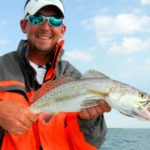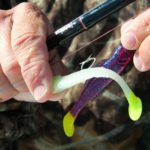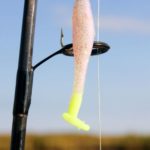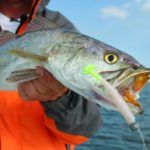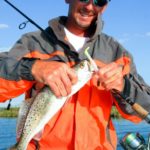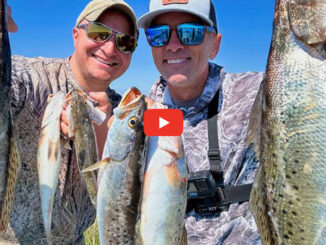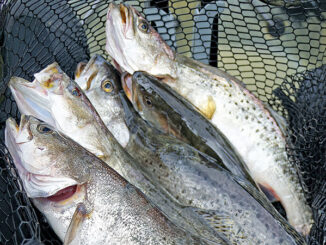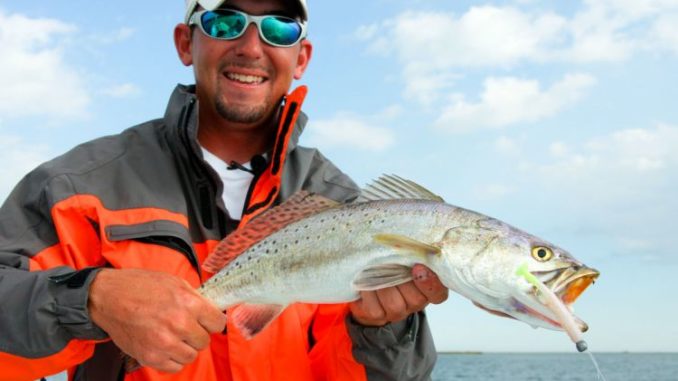
In Delacroix this month, there is no “in-between” trout bite. Fish are either shallow — or they’re deep. Here’s how one guide regularly tracks them down.
Buck Perry, the father of structure fishing, always advised that fish would either be shallow, deep or somewhere in-between.
Perry obviously never fished Delacroix for speckled trout during February — when there really is no in-between.
“Trout are either going to be deep or they’re going to be shallow,” said Capt. Chris Pike with Cast & Blast Charters (504-427-4973).
These bipolar trout are going to be at one extreme or the other because the weather during February — or even during a single day — is just as bipolar as the fish.
“We play the weather this month,” Pike said. “If it’s cold, we fish deep. When it warms up, we fish shallow.
“February is kind of like November in that way because the trout will move with the water temperature.”
And the transformation can take place within only a few hours, like when a cold morning turns into a warm afternoon.
Likely locations
Pike advised anglers to look for shallow spots that have deep-water access nearby.
“It’s more the interior bays and interior channels than the more open bays this time of year,” he said. “We spend our time fishing the more protected areas.”
Some of the best spots that offer this shallow/deep combination are Pointe Fienne Bay, Skippy Lake and Baker’s Bay because of their proximity to Oak River and Four Horse Lake, with the Twin Pipelines nearby.
All these spots are relatively protected and are great for north winds and low water.
“Except for the Twin Pipeline, it’s really all about Oak River,” Pike said. “It’s just a river… more a bayou now… that runs all the way from Caernarvon to Oak River Bay, but the fish are generally between Orange Bayou and Pointe Fienne.”
This particular stretch of Oak River features lots of drains that connect the deep Oak River water with the shallow bays, which is exactly what you’re looking for during February – deep water with shallow water close by.
Pike explained that Oak River generally runs from 10 to 15 feet deep.
“Each one is different,” he said, “but the shallow water you want when it warms up is as close as 200 or 300 yards away from the drains.”
Look for sharp breaks
The best spots within these locations are areas where the water goes from 10 feet up to about 6 feet as sharply as possible.
“When the fish move up, they’re going to stop on that first shelf in about 6 feet of water,” Pike said. “I rely more on my depth finder in February that any other time of the year. I look for that first sharp contour jump, and I want it to be as sharp as possible.”
Pike has learned that the sharper the transition from deep to shallow, the more likely the shallow water is to benefit from the clear water of Oak River.
“Oak River usually stays pretty clear in the deeper holes,” he said. “So the closer the shallow water is to the deep water, the clearer that shallow water is going to be because there’s going to be a little eddy there on those sharp breaks.”
Time the water temperature
When it’s cold, Pike usually likes to fish later in the morning.
“I won’t even leave the dock until 9 or 10 just to get that little bit of warm up,” he said. “And I’ll start in the deep water, until the fish or the water temperature tell me to move shallow.”
One sign that it’s time to move up and check the shallow water is a 3-degree bump in the water temperature.
If everything were perfect, Pike would look for it to bump up to 62 degrees.
“That pushes the trout to the shallow shelves,” he said, “and sunshine is the driving force for that bump up in the water temperature.”
On a cloudy day, Pike has found that the trout will stay deeper longer, and that the water temperature doesn’t seem to affect them as much.
“But on the sunny days, the air temperature doesn’t even matter at all,” he went on. “You get that little jump in the water temperature because of the sun, and they’re moving up.”
Double up with a tandem rig
When first starting out in the morning, Pike loves to fish tandem-rigged purple/chartreuse or straight chartreuse Bomber Mud Minnows on the bottom in deep water.
“I rig a 3/8-ounce (jig)head on bottom and a ¼-ounce head on top,” he said. “For some reason, they don’t seem to want to eat a single head this time of year. I put the 3/8 head on bottom just to give my tandem rig some stability and to get it on down to the bottom, but nine times out of 10 they’re going to eat the ¼ head.”
While the bottom bait doesn’t catch a lot of fish, Pike says it definitely helps him feel the bottom. Oak River is full of clam shells and old cypress, and it typically has a lot of current rolling through it.
“Being able to feel the bottom so I know my bait is down there working where it should be is instrumental to catching them in that deep water,” Pike said.
He almost always fishes his tandem rig with a straight retrieve — there is no bouncing or twitching involved. He reels it as slow as he can without constantly hanging the bottom, with his rod tip down.
“When they eat it, it’s kind of a double tap,” he said. “A lot of times I’ll feel the first tap but can’t feel the fish, so I just keep reeling waiting on the second tap before setting the hook.”
After making the move to shallow water when he sees the temperature bump up, Pike switches to the same Mud Minnows on ¼-ounce heads fished 3 to 4 feet under a cork.
“I’ll run up there and hit a few shallow spots just to see if I can get some reaction bites,” he said. “If I hit those spots and don’t get bit, I assume the fish are still deep, because when they do move shallow, they move up to eat.”
When they are in shallow water, trout tend to be much more aggressive than they are in the deep water. Pike says they’ll take down the corks almost like they would during the summer.
He considers February an ideal month for anglers to learn how to fish with artificial lures instead of live bait.
“Unless it’s crazy hot outside, they’re going to eat the artificials better than live bait,” he said. “So it’s a perfect time to get out there and learn the ins and outs of fishing the plastics because they’re going to be eating them.”
Pike spools up with braided line on his reel while tying his tandem rigs with monofilament or fluorocarbon. He usually ties a swivel to his braided line then ties his leader line to the other end of the swivel.
“I don’t think the swivel is necessary, but it sure does help keep your line twist under control,” Pike added. “I like the SPRO swivels that spin really easy.”
Consistent weather is key
If Mother Nature cooperates, Pike loves a consistent weather pattern during February to keep the fish in predictable locations.
“I want the trout to stay in their winter patterns, so I like consistent weather that keeps the water temperature the same and the water level low,” Pike said. “Maybe several days in the 40s at night, but warming up into the upper 50s or low 60s during the day.”
Although the weather can change rapidly during February, Pike hopes to avoid a lot of hard south winds, and prefers light north winds.
“High water is a definite killer during February,” he said. “They’ll be locked into their winter patterns, then we’ll get south winds and high water and that spreads them out. And high water usually goes with warmer temperatures, which would start pushing them out.
“I want winter to stay winter during February.”
On the other hand, Pike doesn’t want to see any water temperatures below 54 degrees, because he believes that’s just too cold for trout to bite.
Grass can help
Generally speaking, where there is warmer water there will be some kind of vegetation that grows from the bottom.
“And that bottom is usually hard with clam shells or oysters,” Pike said. “The combination of the grass and a hard bottom means the water temperature will warm up even more, which can make for some great fishing.”
Most of the grass in the interior bays close to Oak River tend to grass up on the north or northwest bank.
“I’ve always heard it’s because the sun rises in the east, and those are the first spots of a bay to get that sunshine,” Pike said. “Whatever it is, the closer those grassy banks are to the deep water, the better they’re going to be.”
So by eliminating those “in-between spots,” Pike is able to effectively stay on trout this month.
They’re either going to be shallow, or they’re going to be deep.
Delacroix presents as consistent and easy a trout bite as you’ll find in all of Louisiana during February.
